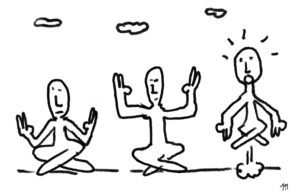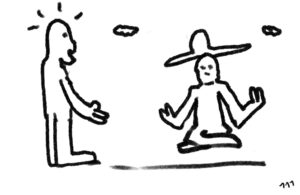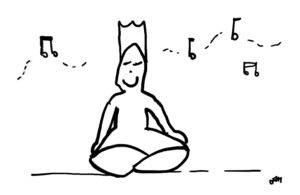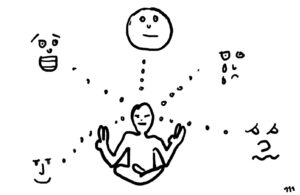Hi I’m Valentina and I am a leading youtuber in the mindfulness and simple life space. Ever since meditation and minimalism became a thing, I’ve been studying scriptures and pursuing a simple life being happy with little. You can read my essays on this webiste.
How To Master Mindfulness? I mean, how to REALLY master this skill ?
In the modern whirlwind of life, finding solace in the gentle art of mindfulness is a quest for inner peace.
Key takeaways
![]() Mindfulness Transforms the way we look at things.
Mindfulness Transforms the way we look at things.
![]() Practice is key.
Practice is key.
![]() Being immersed in a mindful environment helps to maintain the habit.
Being immersed in a mindful environment helps to maintain the habit.
The Essence of Mindfulness

Understanding Mindfulness: At its core, mindfulness is the art of being fully present, engaging with each moment without judgment. It’s about allowing the world to unfold before you with a gentle acceptance, whether it’s in a bustling city or a serene forest.
The Benefits of Practicing Mindfulness:
| Stress | Mental Clarity | Well-being |
|---|---|---|
| Discover tranquility amidst the chaos | Sharpen your thoughts | Deepen your emotional connection |
| Find balance in the midst of turmoil | Boost creativity | Cultivate inner happiness |
| Lighten the mental burden | Enhance decision-making | Foster resilience |
Embracing the Now with Mindfulness
The Essence of Mindfulness: More Than a Buzzword

In a world filled with constant noise and chaos, the concept of mindfulness often emerges as a mere buzzword.
However, to truly embrace the essence of mindfulness is to unlock the door to a life of deep meaning, presence, and peace. It’s not a fleeting trend or a passing fad; it’s a timeless practice that can transform your existence.
At its core, mindfulness is the art of being fully present in the moment.
It’s about paying attention to your thoughts, feelings, and bodily sensations without judgment. This practice may seem deceptively simple, but its impact is profound.
It enables you to connect with the world in ways you’ve never experienced before, fostering a profound sense of clarity and awareness.
Transitioning into this state of mindfulness requires effort and dedication. However, the rewards are immeasurable. By embracing the essence of mindfulness, you open the door to a life of profound presence and purpose.
Mindful Musings: Understanding the Power of Present
The power of the present moment is a force that often eludes us as we navigate our fast-paced lives.
We’re frequently caught up in the hustle and bustle, juggling countless tasks, and racing against the clock. Yet, within this whirlwind, the present moment quietly waits for our attention.
Understanding the power of the present is to comprehend that each moment is a unique gift. It’s an opportunity to savor the beauty of life, appreciate the small details, and find contentment in the simplest of experiences.
When we immerse ourselves fully in the present, we discover that life’s most profound moments often hide in plain sight.
The Mindful Revolution: Tracing the Roots
Ancient Echoes: The Historical Tapestry of Mindfulness
Mindfulness is not a recent invention; it’s an ancient echo that resonates across centuries and cultures. To understand its roots, we must embark on a historical journey that reveals the rich tapestry of mindfulness.
The historical tapestry of mindfulness is woven with threads that trace back to various spiritual and philosophical traditions.
In ancient India, mindfulness found its place in the teachings of Buddhism. The practice of meditation and self-awareness played a central role in the Buddhist path to enlightenment.
Moreover, mindfulness is not confined to a specific region or religion. Taoism in China also emphasizes the importance of being in the present moment and cultivating an awareness of the self and the world.
Similar concepts can be found in various other traditions, such as Stoicism in ancient Greece and the Native American philosophy of living in harmony with nature.
Modern Resurgence: From Monastery to Mainstream

While mindfulness has ancient origins, its resurgence in modern times has been nothing short of a revolution. The practice, once confined to monasteries and the domains of spiritual seekers, has now made its way into mainstream society.
This modern resurgence can be attributed to various factors, including the growing awareness of mental health, the need for stress management in our fast-paced lives, and scientific research supporting the benefits of mindfulness.
In recent decades, mindfulness has gained recognition as a powerful tool for promoting well-being, reducing stress, and enhancing mental clarity. This shift has resulted in mindfulness finding its place in schools, workplaces, and even healthcare settings.
As we continue to explore the roots of this mindful revolution, we’ll delve deeper into its applications and the profound impact it can have on our lives.
The Mindful Mind: Preparing the Inner Soil
Clearing Mental Clutter: Creating Space for Awareness
Our minds are often cluttered with a never-ending stream of thoughts, worries, and distractions. To prepare the inner soil for mindfulness, it’s crucial to embark on a journey of decluttering. This is not about suppressing thoughts but creating space for awareness to flourish.
Think of your mind as a room filled with scattered papers, each representing a different thought or concern. Clearing mental clutter involves organizing those thoughts, acknowledging them, and then gently setting them aside. It’s about creating a mental environment that is conducive to clarity and presence.
One effective way to clear mental clutter is through meditation. Meditation allows you to observe your thoughts without attachment, like watching leaves float by on a stream. This practice enables you to gain control over your mental landscape, making space for mindful awareness to take root.
Attitude of Gratitude: Cultivating the Seeds of Mindfulness
In the garden of mindfulness, an attitude of gratitude is the fertile soil where the seeds of mindfulness can thrive. Gratitude is not merely a polite expression of thanks; it’s a way of seeing the world with appreciative eyes.
Cultivating the seeds of mindfulness through gratitude involves recognizing and appreciating the countless blessings that surround us. It’s about finding joy in the simple things, like the warmth of the sun on your face, a friendly smile from a stranger, or the taste of a delicious meal.
Practicing gratitude doesn’t require a grand gesture. It can be as simple as keeping a gratitude journal, where you jot down a few things you’re thankful for each day. This practice gradually shifts your focus from what’s lacking in your life to the abundance that already exists.
By embracing an attitude of gratitude, you water the seeds of mindfulness, allowing them to grow and flourish. This perspective creates a positive feedback loop, as the more you appreciate the present moment, the more mindfulness naturally becomes a part of your life.
With the inner soil of your mind prepared, you’re ready to explore the art of mindful breathing.
The Art of Mindful Breathing: Life’s Rhythmic Melody
Inhale the Calm, Exhale the Chaos: Breath as an Anchor
The breath is a remarkable anchor to the present moment, a reminder that life unfolds in each inhale and exhale. Inhale deeply, and you draw in a sense of calm and serenity. Exhale fully, and you release the chaos and stress that may be clouding your mind.
Mindful breathing is not about changing your breath but observing it as it naturally flows. It’s a practice that can be done anywhere, anytime, making it a versatile tool for centering yourself in the present moment.
One of the beautiful aspects of mindful breathing is its ability to connect the mind and body. As you pay attention to your breath, you may notice how your body responds – the rise and fall of your chest, the sensation of air passing through your nostrils.
This connection between the mind and body fosters a deeper sense of awareness and unity.
A Symphony of Breaths: Techniques for Every Moment
Mindful breathing is not limited to a single technique; it’s a symphony of breaths, each with its unique melody. There are various breathing techniques you can explore to enhance your mindfulness practice.
- Box Breathing: Inhale for a count of four, hold for four, exhale for four, and pause for four. This technique creates a sense of balance and calm.
- Deep Belly Breathing: Focus on deep breaths that expand your diaphragm and belly. This can help relieve stress and promote relaxation.
- Counting Breaths: Inhale and exhale while counting your breaths, focusing your mind on the rhythmic pattern.
- Guided Meditation: Listen to guided meditations that lead you through breathing exercises and visualization, helping you stay present.
By incorporating these techniques into your daily life, you can harness the power of breath to deepen your mindfulness practice and connect more profoundly with the present moment.
As we continue our journey, we will explore how mindfulness can be woven into the tapestry of daily activities, transforming the mundane into moments of beauty and presence.
Also Read: What is True About Mindfulness in Sport And Exercise?
Mindfulness in Motion: The Dance of Daily Activities
Savoring Simplicity: Finding Mindfulness in Mundane Tasks

One of the wonders of mindfulness is its ability to infuse the ordinary with extraordinary depth. Your daily activities, no matter how routine, can become opportunities for mindful presence.
Imagine savoring the simplicity of washing dishes.
Instead of rushing through the task, you immerse yourself fully in the experience. The warm water caresses your hands, and the gentle clinking of plates becomes a soothing melody. In this moment, you find beauty and peace in the ordinary.
To find mindfulness in mundane tasks, slow down and engage your senses. Pay attention to the textures, smells, and sounds around you. This shift in perspective transforms the routine into a source of joy and connection with the present moment.
Graceful Gestures: Making Mindfulness Move with You
Mindfulness isn’t confined to stillness; it can also be a dance of graceful movements. As you move through your day, you can carry the essence of mindfulness with you.
Walking, for example, can be a mindful practice. With each step, you feel the ground beneath you, the air on your skin, and the rhythm of your body in motion. It’s a form of meditation in action, a way to stay connected to the world as you move through it.
Other daily activities, like yoga or tai chi, can also become a mindful dance. The deliberate and flowing movements invite you to be fully present in your body, creating a sense of unity between your physical and mental selves.
By making mindfulness moves with you, you’ll discover that the present moment is not limited to a specific location or time. It’s a constant companion in your journey through life.
Mindfulness on the Cushion: The Quiet Quest
The Whisper of Silence: Building a Meditation Practice

Meditation is a cornerstone of mindfulness, a dedicated time to retreat within yourself and connect with the whisper of silence. It’s a practice that allows you to dive deep into your inner world, discovering the serenity that resides there.
To build a meditation practice, find a quiet and comfortable space where you won’t be disturbed. Sit or lie down, close your eyes, and focus your attention on your breath. When thoughts arise, gently acknowledge them and return to your breath.
Meditation is not about achieving complete stillness of the mind; it’s about becoming the observer of your thoughts.
The more you engage in meditation, the more you’ll uncover the beauty of the silent spaces between your thoughts. This silence is not empty; it’s rich with awareness and wisdom.
From Flicker to Flame: Growing Consistency and Depth
Consistency is the key to deepening your meditation practice. Start with short sessions and gradually extend the duration as you become more comfortable. By establishing a regular routine, you create a sacred space for mindfulness in your life.
As your meditation practice deepens, you may experience moments of profound insight and clarity. These are like flickers of light in the darkness, illuminating the path of self-discovery. With patience and dedication, these flickers can grow into a steady flame of mindfulness that guides you through every aspect of your life.
Meditation is a lifelong journey, and each session is a step toward a more profound understanding of yourself and the world. It’s a quest for inner peace and a connection to the stillness within.
Feasting Mindfully: Savor Every Bite
The Banquet of Awareness: Eating with Mindful Gusto
Feasting, a daily ritual for most, becomes a gateway to mindfulness when approached with deliberate awareness. Mindful eating is a practice that encourages you to savor every bite, transforming a meal into a banquet of awareness.
Before you begin your meal, take a moment to appreciate the colors, textures, and aromas of your food. As you take your first bite, focus on the flavors and sensations in your mouth. Chew slowly, allowing the taste to linger on your palate.
Mindful eating is not about diets or restrictions; it’s about cultivating a deeper connection with your food and the experience of eating. It allows you to nourish your body and soul simultaneously, fostering a sense of gratitude for the sustenance that sustains you.
Mindful Morsels: Nourishing Body and Soul
Nourishment goes beyond the physical; it extends to the soul. Mindful eating is about nourishing both body and soul, for in the act of eating, you find a profound connection to the world and the interconnectedness of all life.
The act of eating becomes a mindful morsel, a moment of gratitude and reverence for the Earth that provides your sustenance. You become aware of the journey your food has taken from seed to plate, and you honor the labor of those who cultivated it.
As you nourish your body and soul, you foster a sense of harmony and balance. Mindful eating is not a chore; it’s a celebration of life and a reminder of the beauty that resides in the simplest acts.
Mindful Connections: Weaving a Web of Presence
The Touch of Kindness: Mindfulness in Relationships

Mindfulness is not limited to solitary practices; it’s a thread that weaves through our interactions with others. In our relationships, the touch of kindness and presence can transform the ordinary into the extraordinary.
Kindness is the cornerstone of mindful connections. It’s about being fully present with the people you interact with, listening with an open heart, and offering a compassionate response. In our busy lives, genuine connection is often overshadowed by distractions, but mindfulness allows you to rekindle the flame of empathy and understanding.
When you approach your relationships with mindfulness, you create a web of presence that nourishes both you and those you interact with. It’s a reminder that every moment spent with another person is an opportunity to savor the richness of human connection.
Listening to Understand: Communication as a Mindful Practice
Effective communication is a mindful practice that involves not just speaking but also listening. It’s about truly understanding the words, emotions, and intentions of the person in front of you.
In our fast-paced world, listening often takes a backseat to speaking or formulating responses. However, mindful listening invites you to be fully present, to set aside judgments and preconceived notions, and to be a receptive and empathetic listener.
By making communication a mindful practice, you foster deeper connections, build trust, and enhance the quality of your relationships. It’s a reminder that every word spoken and heard has the potential to shape the world around you.
As we delve deeper into the realms of mindfulness, we’ll explore how this practice can guide us through the storms of life and help us find the calm within.
When Mindfulness Meets Challenges: The Calm in the Storm
Surfing the Waves: Mindfulness for Stress and Anxiety
Life often presents us with challenges, and in these moments, mindfulness becomes our anchor in the storm. When faced with stress and anxiety, the practice of surfing the waves of your emotions can provide solace and clarity.
Mindfulness teaches you to acknowledge your feelings without judgment. It’s about observing your stress and anxiety as if they were passing clouds in the sky, knowing that they, too, shall pass. This shift in perspective empowers you to face life’s challenges with equanimity.
One technique for managing stress and anxiety is to focus on your breath. When you feel overwhelmed, take a moment to breathe deeply, inhaling calm and exhaling tension. With each breath, you regain control and find the calm within.
Embracing Impermanence: The Role of Mindfulness in Grief and Loss

Grief and loss are inevitable parts of the human experience, and they test our resilience and emotional strength. Mindfulness, with its emphasis on acceptance and the present moment, can guide us through these difficult times.
In the face of grief, mindfulness encourages us to embrace impermanence, the understanding that everything in life is subject to change. This acceptance does not diminish the pain of loss but allows us to navigate it with grace and fortitude.
Mindfulness is not a shield against suffering but a means to coexist with it. It’s an invitation to feel our grief fully, to honor the memories of those we’ve lost, and to find solace in the support of our loved ones and the enduring beauty of life.
As we journey onward, we’ll explore the significance of creating a mindful life and how it shapes our future.
Cultivating a Mindful Life: Sowing Seeds for the Future
Daily Rituals: Creating a Mindful Ecosystem
The transformation into a mindful life is a gradual process, built on the foundation of daily rituals. These rituals are like seeds that, when tended to with care, grow into a flourishing ecosystem of mindfulness.
Start your day with a mindful morning routine. Wake up with gratitude, savor a moment of silence, and set your intentions for the day. This practice creates a mindful starting point, a reservoir of presence to draw upon as you navigate your daily tasks.
Throughout the day, return to your breath and the present moment. Small moments of mindfulness, like pausing to appreciate a blooming flower or the taste of your lunch, accumulate to shape a mindful life.
End your day with reflection and gratitude. Acknowledge the moments of presence you’ve cultivated and express gratitude for the gifts of the day. This practice reinforces the importance of mindfulness in your life and sets the stage for a restful night’s sleep.
A Mindful Path Forward: Embracing the Journey with Open Arms
Embracing a mindful life is not a destination but a journey, an ongoing process of growth and self-discovery. It’s an invitation to move through life with open arms, fully experiencing each moment with gratitude and awareness.
As you walk this mindful path, you’ll encounter challenges and triumphs, moments of stillness and bursts of joy. Mindfulness is your constant companion, guiding you through the ebb and flow of existence.
With an open heart and a mindful spirit, you’ll find that every step on this journey is a step toward a deeper connection with yourself, with others, and with the world. The future is a canvas waiting for the brushstrokes of your mindful presence.
Conclusion
In conclusion, the essence of mindfulness is not confined to a single practice but encompasses a way of living. It’s an exploration of the present moment, an acknowledgment of life’s impermanence, and a celebration of every breath. By embracing mindfulness, you embark on a transformative journey that can enrich your life in ways you never imagined. So, take that first step, and savor the beauty of the present moment.
Frequently Asked Questions About Mindfulness
What is mindfulness?
Mindfulness is the practice of being fully present and engaged at the moment, aware of your thoughts and feelings without distraction or judgment.
How does mindfulness help reduce stress?
By fostering a state of awareness and acceptance, mindfulness can help interrupt the cycle of stress and anxiety. It teaches you to respond to stressors with calmness and balance.
Can mindfulness improve mental clarity?
Yes, by training your mind to focus on the present moment, mindfulness can clear mental clutter, allowing for improved concentration and decision-making.
What are some simple mindfulness exercises I can start with?
Breath awareness meditation, where you focus solely on your breathing, and the five senses exercise, which grounds you in the present by engaging all your senses, are great starting points.
How long does it take to see the benefits of practicing mindfulness?
The benefits of mindfulness can be noticed almost immediately in some aspects, like a calmer demeanor, but more profound benefits like reduced anxiety may develop over weeks or months of consistent practice.
Do I need a special place to practice mindfulness?
While a quiet and comfortable space can help, mindfulness can be practiced anywhere — whether you’re sitting at your desk, walking in a park, or even doing household chores.
Is mindfulness tied to a particular religion or belief system?
Mindfulness, though rooted in Buddhist meditation, is a secular practice that transcends religious and cultural boundaries, making it accessible to everyone.
Can mindfulness help with emotional well-being?
Absolutely. Regular mindfulness practice can lead to an enhanced emotional state, greater resilience to emotional stressors, and an overall sense of well-being.
How does mindfulness integrate into daily life activities?
Mindfulness can be incorporated into daily life by consciously paying attention to your actions, whether you’re eating, communicating, or working, and doing so with full presence and awareness.
What should I do if I struggle with maintaining a mindfulness practice?
Be patient with yourself and acknowledge that practice makes progress. It’s common to encounter challenges. Consider joining a mindfulness group or seeking guidance from mindfulness apps or a coach.
How can I overcome distractions during mindfulness practice?
Recognize that distractions are a natural part of the process. Gently acknowledge them and refocus your attention back on the practice without self-criticism.
Is it possible to practice mindfulness while walking or doing other physical activities?
Yes, mindfulness can be practiced through mindful walking or yoga, where the focus is on movement and breath, aligning physical activity with mental presence.
How does mindfulness contribute to relationships and communication?
Mindfulness can improve the quality of interactions with others by fostering active listening, empathy, and non-reactive communication, leading to deeper connections.
What’s the best way to maintain consistency in mindfulness practice?
Set realistic goals, create a routine, and use reminders or cues to integrate practice into your daily schedule. Consistency comes from making mindfulness a regular part of your life.
Does practicing mindfulness require a lot of time each day?
No, even just a few minutes of mindfulness each day can be beneficial. The key is regular, consistent practice, not the length of time spent.
And here’s a YouTube video link that delves into the topic of mindfulness: YouTube Video on Mindfulness